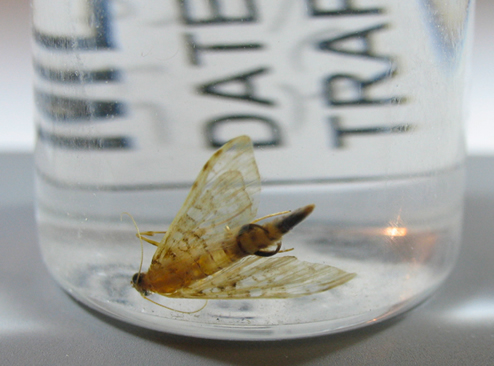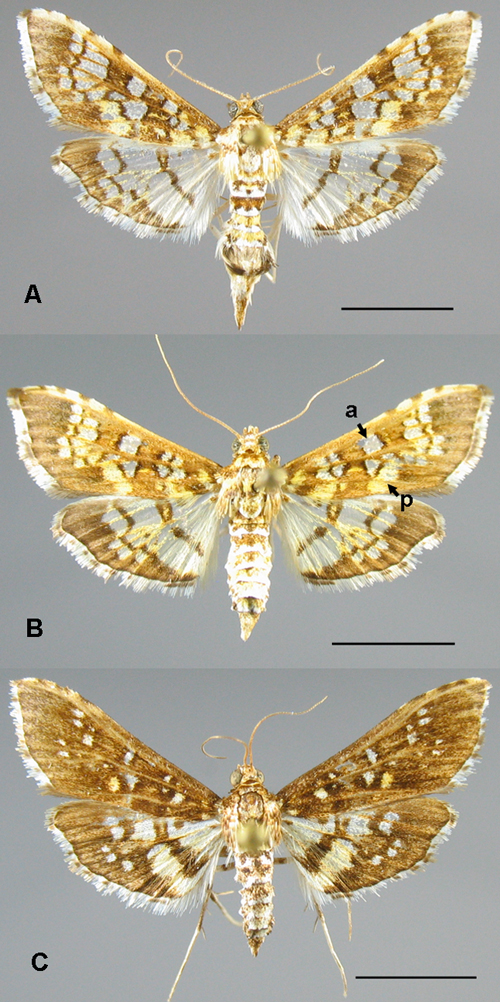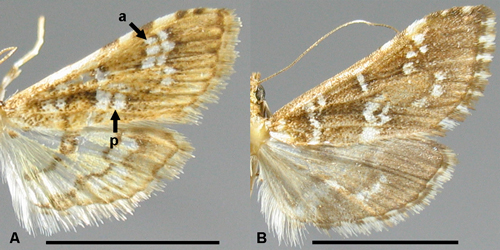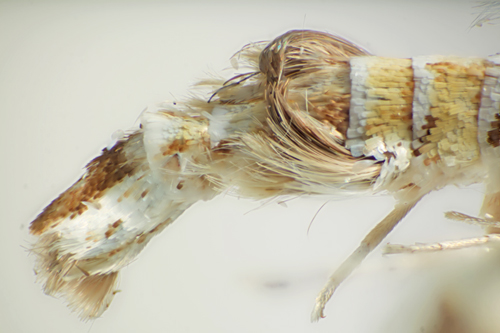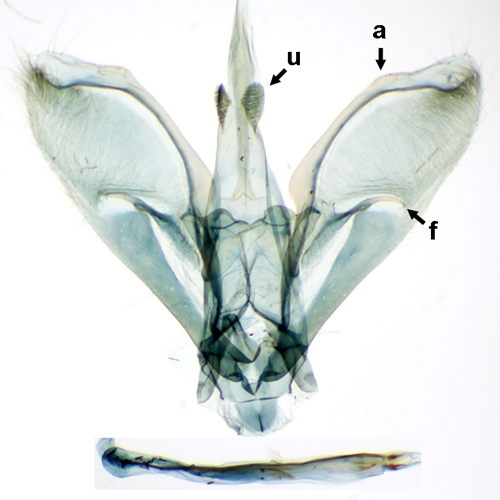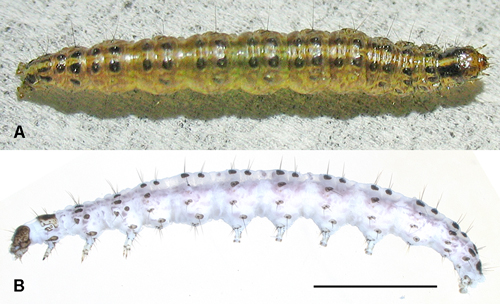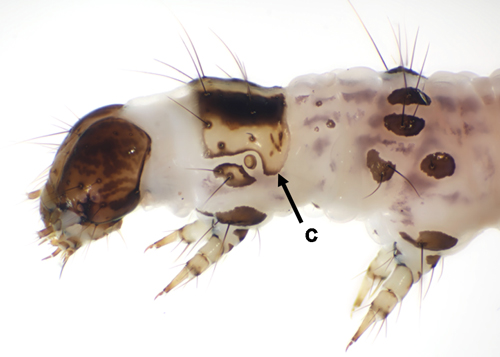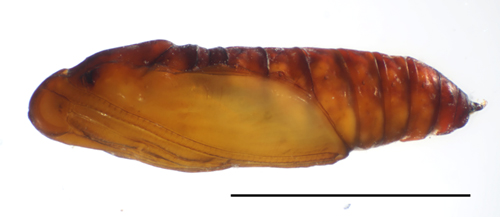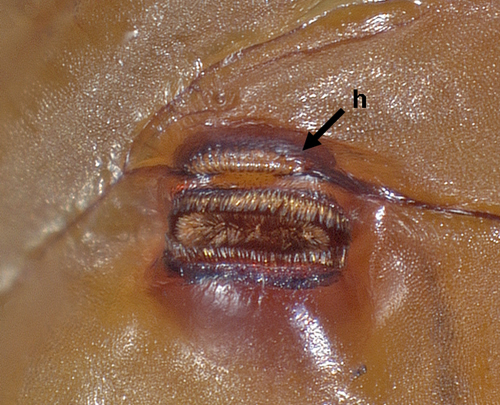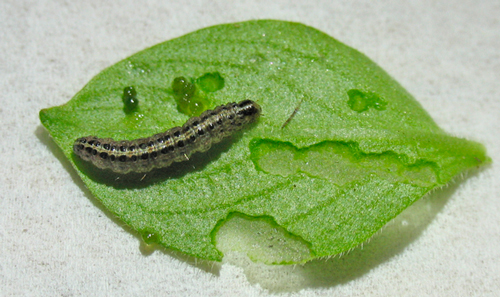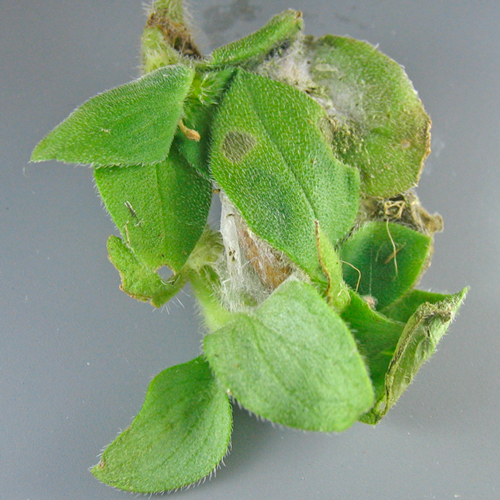common name: stained-glass moth
scientific name: Samea ecclesialis Guenée (Insecta: Lepidoptera: Crambidae)
Introduction - Distribution - Identification - Description - Hosts - Behavior - Similar Species - Selected References
Introduction (Back to Top)
Samea ecclesialis Guenée (Lepidoptera: Crambidae: Spilomelinae) is a common moth that is widely distributed in Florida, the southern United States, and the New World tropics. It is often seen flying on lawns and weedy areas, and it is one of the most frequently attracted moths to Multi-Lure® (McPhail-type) traps deployed in Florida for tephritid fruit fly detection (Fig. 1). Despite the moth's abundance, it has no reported economic importance. However, it is related to Samea multiplicalis (Guenée) and Niphograpta albiguttalis (Warren), well-studied herbivores of aquatic weeds (Center et al. 1982; Knopf and Habeck 1976), and to Nomophila Hübner, the celery webworms, which are pests of herbaceous plants and young vegetables (Flint 1922).
Figure 1. Samea ecclesialis male in Multi-Lure® trap sample. Photograph by James E. Hayden.
Distribution (Back to Top)
The species is distributed across the southeastern U.S., Caribbean, Central America and South America as far as southern Brazil. Of Florida, Kimball (1965) notes that it "is found all over the state, is very common and is flying all the year." Specimens in the Florida State Collection of Arthropods from Alachua County are from all months, and all major regions of Florida are represented.
Identification (Back to Top)
Adult: The forewing length is 8.5-11 mm, males having slightly more pointed forewings (Fig. 2A). The wing pattern is a complex array of opaque brown and nearly translucent windows (Fig. 2A-C). Guenée's description (1854) compares the pattern to stained glass (vitraux), hence the species name in reference to churches. Males are easily distinguished from all similar species in North America by the presence of nearly black scale tufts on the sides of the fifth abdominal segment (Fig. 4). The windows of the forewing are roughly arrayed in three bands. In the medial band, the window nearer the anterior margin of the wing is roughly square (Fig. 2B: a). The posterior window is divided in three sections, of which the distal and posterior sections are filled with yellow scales (Fig. 2B: p); the three subdivisions are roughly equal in size. The translucent areas of the hind wing are larger, and the brown lines are sharply defined. The translucent areas are more extensive in males than in females, and some females are "melanic" in that the windows are strongly reduced (Fig. 2C). The fringe of the forewing alternates white and brown, with nearly continuous brown in the middle third of the distal margin.
Figure 2. Samea ecclesialis. A, male; B, female; C, melanic female. a, anterior spot; p, posterior spot. Scale bars = 5 mm. Photograph by James E. Hayden.
Figure 3. Wings: A, Samea multiplicalis; B, Samea druchachalis. a, anterior spot; p, posterior spot. Scale bars = 5 mm. Photograph by James E. Hayden.
Figure 4. Abdominal tufts on segment five of male Samea ecclesialis. Photograph by James E. Hayden.
The male genitalia (Fig. 5) have one fibula (or clasper) on each valva (f), and the uncus (u) is apically divided into two setose pads. The dorsal margin of the valva is obtusely angulate (a), but the angle does not bear the robust chaetae seen in species of Diacme Warren (not illustrated). The signum of the female genitalia is a pair of toothed sclerites arrayed transversely in the corpus bursae (Fig. 6: s). This shape is shared only with Samea druchachalis Dyar. Other related North American species instead have a long, granulose ridge running longitudinally in the corpus bursae, or no signum at all (as in Samea multiplicalis).
Figure 5. Male genitalia of Samea ecclesialis. a, obtuse angle of valva; f, fibula; u, bifid uncus. Photograph by James E. Hayden.
Figure 6. Female genitalia of Samea ecclesialis. s, signum. Photograph by James E. Hayden.
Egg: The eggs are scale-like (flattened) and laid singly or in small groups.
Larva: The most diagnostic character is the extension of the posterior corner of the prothoracic shield posteriad of the spiracle (Fig. 8: c). The lateral pinaculum is separate from the shield and is extended ventrad, but not posteriad of the spiracle. The larva keys out variously to Herpetogramma pertextalis (Lederer) or Nomophila nearctica Munroe in Allyson (1984), to Pyrausta Schrank in Allyson (1981), to Pyrausta or various Spilomelinae in Solis (2006), and to Nomophila, Udea Guenée, or Mecyna Doubleday in Hasenfuss (1960: 173-175).
Figure 7. Samea ecclesialis: A, live larva; B, preserved larva. Scale bar = 5 mm. Photograph by James E. Hayden.
Figure 8. Larval prothoracic shield of Samea ecclesialis. c, corner of shield in Multi-Lure trap sample. Photograph by James E. Hayden.
Description (Back to Top)
Terms follow Stehr (1987). Length of last-instar larva 18-20 mm. Body greenish yellow; integument microscopically smooth (Fig. 7). All pinacula evenly grayish brown, D and SD pinacula darker than the others. Extra pinacula absent; some proprioceptor setae ringed with gray. Legs yellow with segmental margins and tarsus gray-brown. Crochets triordinal in incomplete circle.
Head: Light brown mottled with dark brown; broad, diffuse, brown genal streak present. Frons extended 2/3 to epicranial notch. AF2 setae transversely aligned with (on same level as) apex of frons. P1, P2, AF2 forming right angle; distance P1-P2 about half P1-AF2. Six closely spaced stemmata, 1 and 6 larger than others. Mandible with 2-3 small lateral teeth, 4 large teeth in middle, and mesal margin with 3 minute lobes; mandible with two setae on lateral margin, without retinaculum.
Thorax: Prothoracic shield yellow along dorsal midline; broad, dark brown submedial stripe about XD1, D1 and D2; laterally yellow about XD2, SD1 and SD2, these setae ringed with gray, and shield with gray margins; SD2 ventral of D2 and posterior of, slightly above level of XD2. Posteroventral corner of T1 shield extended posterior of spiracle to below ventral margin of spiracle. L pinaculum marginally brown, medially yellow; extended ventral of spiracle as far as its posterior margin; not fused with corner of T1 shield. Two SV setae present. Thoracic V setae on small, round pinacula, separate except in some cases fused on T1. Segments T2, T3 with D and SD pinacula separate; D2 and SD2 setae posterodorsal of D1 and SD1 setae respectively. SD setae not hair-like. Three L setae; 1 SV seta.
Abdomen: D1 and D2 pinacula separate, rounded, not enlarged; D2 seta directly posterior of D1 seta. SD2 seta not on SD1 pinaculum. SD pinaculum reduced on A2 and A7. D1-D2 distance equal to D1-SD1; D2-D2 roughly equal to D1-D1. L1 posterodorsal of L2 on all segments. SV group with 3 setae on A1-A6, 2 on A7, 1 on A8-A9. SV1 anterodorsal of spiracle. A9: D2 setae on common pinaculum, pigmented laterally; D1 and SD1 on fused pinaculum; SD1 hairlike, directly posterior of D1 and ventral of D2. A10: anal shield medially unpigmented. D2-D2 distance slightly less than D1-D1, greater than D2-SD1. V1-SV4 closer than SV2-SV3.
Pupa: The pupa (Fig. 9) keys to Nomophila or Mecyna in Patočka (2001), with which it shares a raised, crenulate hood like a thick lip along the anterior side of each thoracic spiracle (Fig. 10: h). It differs from these and from Nomophila albiguttalis by the equilaterally triangular cremaster. Abbreviated description: length 8-9 mm. Head rounded, not humped. Labrum poorly differentiated, triangular, with concave margins. Labial palpi proximally parallel-sided, distally extended to a point. Pilifers not touching. Thoracic spiracles as described above. Thorax and abdomen without other deep grooves or hoods. Dorsal setae not grouped on projections. Appendages not projected onto fifth segment. Metatarsi not visible. Abdomen without gin-traps (intersegmental clefts). Spiracles not raised or barely so. Cremaster triangular, as long as wide, distally pointed, with six evenly spaced setae, without grooves.
Figure 9. Samea ecclesialis pupa. Scale bar = 5 mm. Photograph by James E. Hayden.
Figure 10. Samea ecclesialis, detail of pupal thoracic spiracle. h, lip-like hood anterior of spiracle. Photograph by James E. Hayden.
Hosts (Back to Top)
The figured larvae were raised on Richardia brasiliensis Gomes (Tropical Mexican clover). Thus far,
reports of feeding on aquatic plants have been found to be misidentified Samea multiplicalis.
Behavior (Back to Top)
Larvae spin slight webs among leaves and graze the epidermis of either leaf side, forming rounded
windows (Fig. 11). The time from hatching to pupation takes about one month. They spin a white silken shelter among leaves for pupation (Fig. 12). The adults often fly into Multi-Lure® traps, with 33 submissions to DPI Entomology by this sampling method and another 27 by other methods from May 2011 to September 2014. Adult moths frequently settle on flowers to drink nectar at night, accumulating high pollen loads (Atwater 2013), and they have been reported to gain nutrients by drinking the tears of livestock (Büttiker 1997).
Figure 11. Larval Samea ecclesialis on Richardia brasiliensis. Photograph by James E. Hayden.
Figure 12. White cocoons of Samea ecclesialis among leaves of Richardia brasiliensis. Photograph by James E. Hayden.
Similar Species (Back to Top)
Samea Guenée is related to genera in the Mecyna group (Munroe 1995), such as Diacme, Mecyna, Nomophila, Mimorista Warren and Niphograpta Warren. The characters that separate these genera have not been reviewed to date, and all have similar wing patterns. Samea multiplicalis is smaller (forewing length 7-9 mm) and paler brown (Fig. 3A). The white spot near the forewing costa is narrow rather than square, and the spots near the posterior edge are not yellow. Samea druchachalis, known from Mexico and Texas, has appeared in Florida in recent years, represented by a few specimens from Central Florida and both coasts (Martin County, 1999; Lee County, 2000; Marion County, 2000, 2007; in the Florida State Collection of Arthropods and Terhune S. Dickel Collection, Anthony, Florida) and recent photographs (BugGuide 2013). The forewing length of Samea druchachalis is 8 mm (Fig. 3B). The color is similarly dark brown, but the white spots are as in Samea multiplicalis. The hind-wing lines are diffusely smudged. Species of Diacme have yellowish wing cell bands that are joined and more or less continuous. The North American species have one or more robust chaetae at the subapical angle of the male valve (cf. Fig. 5). In larvae of Samea multiplicalis, Nomophila nearctica, and Niphograpta albiguttalis, the T1 shield corners are not extended posteriad of the spiracle, although in Samea multiplicalis, the posterior corner of the T1 shield may project slightly.
Few other Lepidoptera are recorded to feed on Richardia L. in Florida (Heppner 2003), primarily hornworms (Sphingidae), which are easily distinguished by their large size, caudal horn, and crochets in mesoseries.
Acknowledgements (Back to Top)
Unpublished notes of the late Dale H. Habeck (University of Florida) indicated that Samea ecclesialis feeds on Richardia. I thank Louis Somma (FDACS-DPI) for gathering specimen data. Julieta Brambila (USDA-APHIS-PPQ), Deborah Matthews Lott (University of Florida), Paul Skelley (FDACS-DPI), Greg Hodges (FDACS-DPI) and Wayne Dixon (FDACS-DPI) provided many helpful suggestions for improving the manuscript.
Selected References (Back to Top)
- Allyson S. 1981. Last instar larvae of Pyraustini of America north of Mexico (Lepidoptera: Pyralidae). Canadian Entomologist 113: 463-518.
- Allyson S. 1984. Description of last instar larvae of 22 species of North American Spilomelini (Lepidoptera: Pyralidae: Pyraustinae) with a key to species. Canadian Entomologist 116: 1301-1334.
- Atwater MM. 2013. Diversity and nectar hosts of flower-settling moths within a Florida sandhill ecosystem. Journal of Natural History 47: 2719-2734.
- BugGuide. 2013. Species Samea druchachalis. Hosted by Iowa State University Entomology, Ames, IA, USA (accessed 23 September 2014).
- Büttiker W. 1997. Field observations on ophthalmotropic Lepidoptera in southwestern Brazil (Paraná). Revue Suisse de Zoologie 104: 853-868.
- Center TD, Balciunas JK, Habeck DH. 1982. Descriptions of Sameodes albiguttalis (Lepidoptera: Pyralidae) life stages with key to Lepidoptera larvae on waterhyacynth [sic]. Annals of the Entomological Society of America 75: 471-479.
- Flint WP. 1922. Studies of the life history of Nomophila noctuella. Annals of the Entomological Society of America 15: 154-156.
- Guenée MA. 1854. Deltoides et Pyralites. Pp. 1-448 In: J.B.A.D. de Boisduval and M.A. Guenée (eds.). Histoire Naturelle des Insectes. Species Général des Lépidoptères 8. Roret, Paris.
- Hasenfuss I. 1960. Die Larvalsystematik der Zünsler (Pyralidae). Abhandlungen zur Larvalsystematik der Insekten 5: 1-263.
- Heppner JB. (ed.). 2003. Lepidoptera of Florida. Part 1. Introduction and Catalog. Arthropods of Florida and Neighboring Land Areas 17: 1-670.
- Kimball CP. 1965. Lepidoptera of Florida. Arthropods of Florida and Neighboring Land Areas 1: i-v, 1-363.
- Knopf KW, Habeck DH. 1976. Life history and biology of Samea multiplicalis. Environmental Entomology 5: 539-542.
- Munroe EG. 1995. 1995. Crambidae. Pp. 34-79. In: J.B. Heppner (ed.). Atlas of Neotropical Lepidoptera.
Checklist: Part 2 (3). Association for Tropical Lepidoptera and Scientific Publishers, Gainesville, FL, USA.
- Patočka J. 2001. Die Puppen der mitteleuropäischer Zünsler (Lepidoptera: Pyraloidea, Pyralidae). Unterfamilien Acentropinae, Odontiinae, Evergestinae und Pyraustinae. Linzer Biologische Beiträge 33: 347-405.
- Solis MA. 2006. Key to selected Pyraloidea (Lepidoptera) larvae intercepted at U.S. ports of entry. Hosted by USDA ARS SEL, Washington, D.C. USA (accessed 23 September 2014).
- Stehr FW. 1987. Order Lepidoptera. Pp. 288-596. In: Stehr FW (ed.). Immature Insects, Volume 1. Kendall/Hunt, Dubuque, IA, USA.
